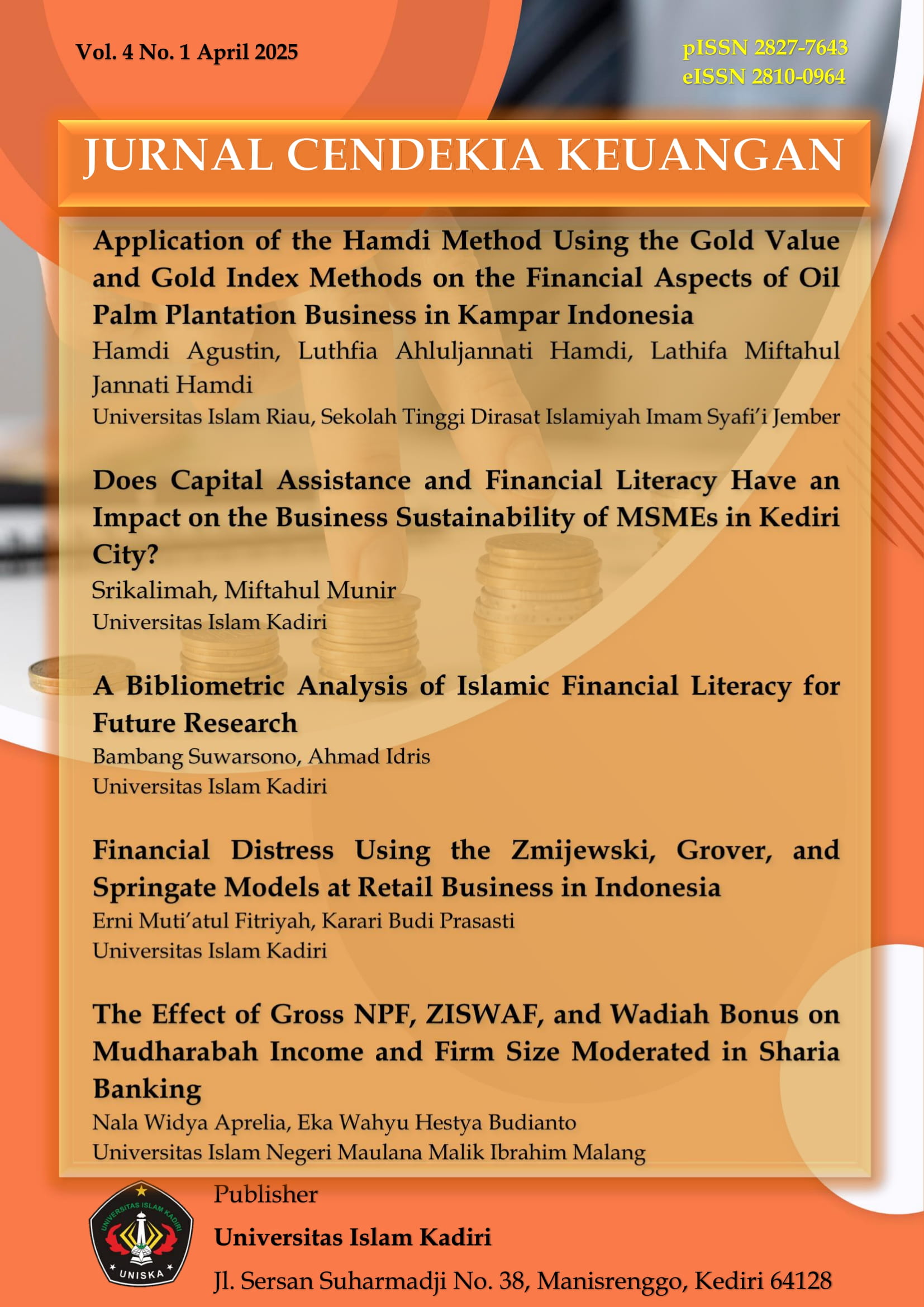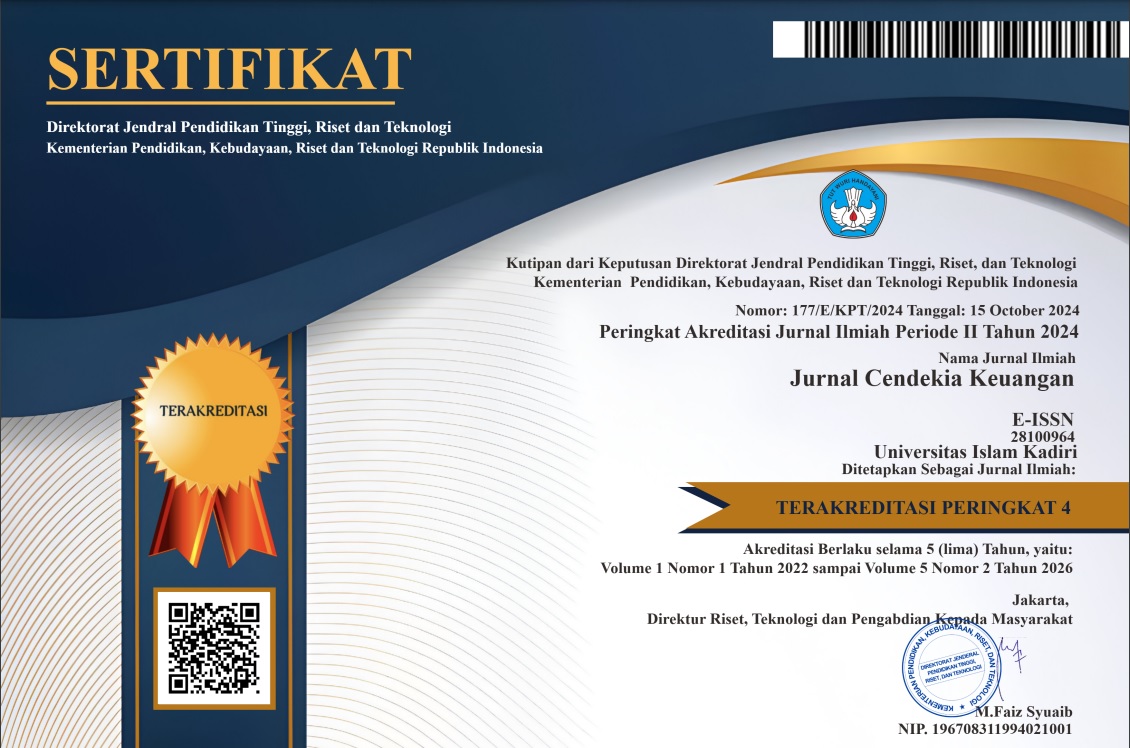A Bibliometric Analysis of Islamic Financial Literacy for Future Research
Abstract
Introduction/Main Objectives: This study is to provide a wider bibliometric literature review on Islamic financial literacy (IFL). Background Problems: IFL requieres a comprehensive review of existing studies. Looking for potential topics is one way to develop knowledge in IFL by using bibliometric studies. Novelty: This paper is to fill in the gaps by providing an extensive bibliometric analysis of the literature related to IFL. Research Methods: We analyzed 57 articles published from 2016 until 2024, a 9 year period. Articles were taken from the Scopus database. We studied classify articles using VOSviewer software. We analyzed citation and analysis co-occurrence. Finding/Results: The topic of IFL is still in demand today. Indonesia and Malaysia are the countries with the most productive in terms of the number of documents. Six thematic clusters: The red clusters include demographic variables, financial inclusion, financial literacy, halal, Islamic banking services, Islamic capital market, Islamic Finance, and Islamic financial literacy. The green cluster includes COVID-19, Finance, human, literacy, self-concept, and self-efficacy. The blue cluster includes banking, intention to use, Islamic financial inclusion, and marketing. The yellow cluster includes behavioural intention, Islamic banking, Islamic financial services, and Islamic marketing. The orange cluster include intention, market discipline, sharia mutual funds, and subjective norm. The purple cluster include financial socialization and religiosity. The following topics have attracted the greatest attention: Islamic Financial Inclusion, Islamic Capital Market, Halal, Religiosity, Self-Concept, and Self-Efficacy. Research limitation/implications: This paper highlights the interconnectedness of education, personal behavior, and financial products within the Islamic finance framework. This structured breakdown aligns the elements that influence Islamic finance development, providing a pathway for examining how literacy, behavior, and products shape the field.
References
Adrianto, F. (2021). The Prospect of Indonesian Government Retail Sukuk: From the Perspective of Sharia Financial Knowledge, Education, and Behavior. DLSU Business and Economics Review, 30(2), 50–60. https://www.dlsu.edu.ph/wp-content/uploads/2021/04/4adrianto-041121.pdf
Ajzen, I. (1991). The Theory of Planned Behavior. Organizational Behavior and Human Decision Processes, 50, 179–211.
Al-Awlaqi, M. A., & Aamer, A. M. (2023). Islamic financial literacy and Islamic banks selection: an exploratory study using multiple correspondence analysis on banks’ small business customers. International Journal of Emerging Markets, 18(12), 6285–6299. https://doi.org/10.1108/IJOEM-09-2021-1354
Albaity, M., & Rahman, M. (2019). The intention to use Islamic banking: an exploratory study to measure Islamic financial literacy. International Journal of Emerging Markets, 14(5), 988–1012. https://doi.org/10.1108/IJOEM-05-2018-0218
Andespa, R., Yeni, Y. H., Fernando, Y., & Sari, D. K. (2024). A systematic review of customer Sharia compliance behaviour in Islamic banks: determinants and behavioural intention. Journal of Islamic Marketing, 15(4), 1013–1034. https://doi.org/10.1108/JIMA-06-2023-0181
Antara, P. M., & Musa, R. (2020). Validating islamic financial literacy instruments among mum generation: Rasch analysis approach. International Journal of Business and Society, 21(3), 1113–1121. https://doi.org/10.33736/ijbs.3315.2020
Antara, P. M., Musa, R., & Hassan, F. (2017). Conceptualisation and operationalisation of islamic financial literacy scale. Pertanika Journal of Social Sciences and Humanities, 25(February), 251–260.
Bedi, H. S., Karn, A. K., Kaur, G. P., & Duggal, R. (2019). Financial Literacy-A Bibliometric Analysis. Financial Literacy-A Bibliometric Analysis. Our Heritage, 67(10), 1042–1054.
Billings, J. S. (1881). An address on our medical literature. British Medical Journal, 2(1076), 262–268. https://doi.org/10.1136/bmj.2.1076.262
Daradkah, D., Aldaher, A. A., & Shinaq, H. R. (2020). Islamic financial literacy: Evidence from Jordan. Transition Studies Review, 27(2), 109–123. https://doi.org/10.14665/1614-4007-27-2-009
Dinc, Y., Çetin, M., Bulut, M., & Jahangir, R. (2021). Islamic financial literacy scale: an amendment in the sphere of contemporary financial literacy. ISRA International Journal of Islamic Finance, 13(2), 251–263. https://doi.org/10.1108/IJIF-07-2020-0156
Dinc, Y., Çetin, M., & Jahangir, R. (2023). Revisiting the concept of Islamic financial literacy in a boundaryless context: cross-country comparison of Islamic financial literacy. Journal of Islamic Accounting and Business Research, 14(8), 1364–1382. https://doi.org/10.1108/JIABR-02-2022-0043
Gallego-Losada, R., Montero-Navarro, A., Rodríguez-Sánchez, J.-L., & González-Torres, T. (2022). Retirement planning and financial literacy, at the crossroads. A bibliometric analysis. Finance Research Letters, 44. https://doi.org/10.1016/j.frl.2021.102109
Goyal, K., & Kumar, S. (2021). Financial literacy: A systematic review and bibliometric analysis. International Journal of Consumer Studies, 45(1), 80–105. https://doi.org/10.1111/ijcs.12605
Gunawan, A. (2023). Sharia Financial Knowledge And Financial Behavior As A Basis For Measuring Financial Literacy. Quality - Access to Success, 24(193), 92–99. https://doi.org/10.47750/QAS/24.193.11
Hanif, M., & Zafar, K. (2020). Developments in Islamic finance literature: Evidence from specialized journals. Journal of King Abdulaziz University, Islamic Economics, 33(2), 3–23. https://doi.org/10.4197/Islec.33-2.1
Harun, H. F., Sarman, M. A., & Kamaruddin, S. H. (2024). Determinants of Islamic Financial Literacy in OIC Countries: A Comprehensive Systematic Review and Analysis. Journal of Economic Cooperation and Development, 45(1), 227–248.
Haynes, G., Hogarth, J., Hunt, R., Rose, P., Shim, S., & Worley, T. (2006). Applying the Theory of Planned Behavior to Retain Credit Counseling Clients.
Heersmink, R., van den Hoven, J., van Eck, N. J., & van Berg, J. den. (2011). Bibliometric mapping of computer and information ethics. Ethics and Information Technology, 13(3), 241–249. https://doi.org/10.1007/s10676-011-9273-7
Hidajat, T., & Hamdani, M. (2017). Measuring Islamic Financial Literacy. Advanced Science Letters, 23(8), 7173–7176. https://doi.org/10.1166/asl.2017.9321
Idris, A., Rahmawati, A., Surwanti, A., & Hanafi, M. M. (2023). Financial Literacy to Improve Sustainability: A Bibliometric Analysis. Studies in Business and Economics, 18(3), 24–43. https://doi.org/10.2478/sbe-2023-0043
Ingale, K. K., & Paluri, R. A. (2020). Financial literacy and financial behaviour: a bibliometric analysis. Review of Behavioral Finance, 14(1), 130–154. https://doi.org/10.1108/RBF-06-2020-0141
Khamis, F. M., Isa, M. Y. B., & Yusuff, N. B. (2024). Perceived inclusion of Islamic finance: The effects of attitudes, experience, literacy, religiosity, and social influences. International Journal of Applied Economics, Finance and Accounting, 18(2), 321–338. https://doi.org/10.33094/ijaefa.v18i2.1398
Kusumawati, I. B., Fachrudin, A. D., & Indra Putri, R. I. (2023). Infusing Islamic financial literacy in mathematics education for Islamic school. Journal on Mathematics Education, 14(1), 19–34. https://doi.org/10.22342/JME.V14I1.PP19-34
Mahdzan, N. S., Zainudin, R., & Au, S. F. (2017). The adoption of Islamic banking services in Malaysia. Journal of Islamic Marketing, 8(3), 496–512. https://doi.org/10.1108/JIMA-08-2015-0064
Mahdzan, N. S., Zainudin, R., Wan Ahmad, W. M., & Hanifa, M. H. (2024). Does Islamic financial literacy and motives influence the holdings of Islamic financial products? A study on bank customers in Klang Valley, Malaysia. Journal of Islamic Marketing, 15(9), 2286–2309. https://doi.org/10.1108/JIMA-05-2022-0158
Majeed, M. T., & Zainab, A. (2021). A comparative analysis of financial performance of Islamic banks vis-à-vis conventional banks: evidence from Pakistan. ISRA International Journal of Islamic Finance, 13(3), 331–346. https://doi.org/10.1108/IJIF-08-2018-0093
Moed, H. F., Burger, W. J. M., Frankfort, J. G., & Van Raan, A. F. J. (1985). The use of bibliometric data for the measurement of university research performance. Research Policy, 14(3), 131–149. https://doi.org/10.1016/0048-7333(85)90012-5
Nathie, M., Mahdzan, N. S., Hanifa, M. H., Ahmad, W. M. W., & Zainudin, R. (2023). Islamic and Conventional Financial Literacy: Systematic and Bibliometric Literature Analyses. Journal of King Abdulaziz University, Islamic Economics, 36(2), 29–60. https://doi.org/10.4197/Islec.36-2.2
Nicholas, D., & Ritchie, M. (1978). Literature and bibliometrics. C. Bingley.
Osman, I., Syed Alwi, S. F., Rehman, M. A., Muda, R., Hassan, F., Hassan, R., & Abdullah, H. (2024). The dilemma of millennial Muslims towards financial management: an Islamic financial literacy perspective. Journal of Islamic Marketing, 15(1), 59–78. https://doi.org/10.1108/JIMA-09-2021-0283
Pala, F., Erdoğdu, A., Ali, M., Alnori, F., & Barut, A. (2024). Analyzing the linkage between Islamic financial literacy and Islamic banking services adoption: evidence from Turkey. Journal of Islamic Accounting and Business Research, 15(5), 784–817. https://doi.org/10.1108/JIABR-12-2021-0324
Patrisia, D., Abror, A., Dastgir, S., & Rahayu, R. (2023). GENERATION Z’s FINANCIAL BEHAVIOUR: THE ROLE OF ISLAMIC FINANCIAL LITERACY. ISRA International Journal of Islamic Finance, 15(2), 20–37. https://doi.org/10.55188/ijif.v15i2.540
Pritchard, A. (1969). Statistical bibliography or bibliometrics. Journal of Documentation, 25(4), 348–349.
Rahayu, R., Ali, S., Hidayah, R., & Aulia, A. (2024). Examining the role of family and social factors on Islamic financial literacy: evidence from Indonesia. Journal of Islamic Marketing, 15(9), 2165–2180. https://doi.org/10.1108/JIMA-07-2023-0213
Rahim, S. H. A., Rashid, R. A., & Hamed, A. B. (2016). Islamic financial literacy and its determinants among university students: An exploratory factor analysis. International Journal of Economics and Financial Issues, 6(7Special Issue), 32–35.
Setiawati, R., Nidar, S. R., Anwar, M., & Masyita, D. (2018). Islamic financial literacy: Construct process and validity. Academy of Strategic Management Journal, 17(4).
Sumiati, A., Widyastuti, U., Takidah, E., & Suherman. (2021). The millennials generation’s intention to invest: A modified model of the theory of reasoned action. International Journal of Entrepreneurship, 25(3), 1–11.
Trisanty, A., Haryanto, B., Sugiarto, C., & Wahyudi, L. (2024). Testing the role of skepticism in Islamic banks: evidence from Indonesia. Cogent Business and Management, 11(1). https://doi.org/10.1080/23311975.2024.2364842
Utomo, S. B., Sekaryuni, R., Widarjono, A., Tohirin, A., & Sudarsono, H. (2020). Promoting Islamic financial ecosystem to improve halal industry performance in Indonesia: a demand and supply analysis. Journal of Islamic Marketing, 12(5), 992–1011. https://doi.org/10.1108/JIMA-12-2019-0259
Wijaya, H. R., Hati, S. R. H., Ekaputra, I. A., & Kassim, S. (2024). The impact of religiosity and financial literacy on financial management behavior and well-being among Indonesian Muslims. Humanities and Social Sciences Communications, 11(1). https://doi.org/10.1057/s41599-024-03309-6
Yeni, F., Mulyani, S. R., & Susriyanti, S. (2023). Islamic financial literacy, spiritual intelligence, public perception and behaviour on public interest in Islamic banking services. Cogent Economics and Finance, 11(1). https://doi.org/10.1080/23322039.2023.2175470
Zaman, Z., Mehmood, B., Aftab, R., Shahid, M., & Ameen, Y. (2017). Role of Islamic Financial Literacy in the Adoption of Islamic Banking Services : An Empirical Evidence from Lahore , Pakistan. Journal of Islamic Business and Management, 7(2), 230–247.

This work is licensed under a Creative Commons Attribution-ShareAlike 4.0 International License.














